“Maverick McCain” and the Resurrection of the US Dollar
Currencies / US Dollar Sep 10, 2008 - 04:50 PM GMTBy: Gary_Dorsch

 “As soon as you think you've got the key to the stock market, they change the lock,” lamented Joe Granville, who is mostly remembered for his bearish calls on the US stock market during the 1970's, 1980's, and the 1990's. Nowadays, many currency traders are scratching their heads, trying to figure out what's behind the sudden resurrection of the US-dollar, which is flexing its muscles for the first time in two-years, and defying conventional logic, by climbing sharply higher against most foreign currencies, including those that offer much higher rates of interest.
“As soon as you think you've got the key to the stock market, they change the lock,” lamented Joe Granville, who is mostly remembered for his bearish calls on the US stock market during the 1970's, 1980's, and the 1990's. Nowadays, many currency traders are scratching their heads, trying to figure out what's behind the sudden resurrection of the US-dollar, which is flexing its muscles for the first time in two-years, and defying conventional logic, by climbing sharply higher against most foreign currencies, including those that offer much higher rates of interest.
The Euro has plummeted 12% vs the US-dollar since July 15 th , tumbling to as low as $1.410 today. Earlier this week, Euro-zone Finance chief Jean-Claude Juncker gave currency traders the green-light to trash the Euro. “Things are developing in the right direction, in line with the commitments of the US Treasury that it stated in recent months. The Euro is less than $1.44, and it reflects economic fundamentals better than the Euro flirting with $1.60. I still think that the Euro is overvalued, not only against the dollar, but also against other currencies,” he said.
There's been a major shift in market psychology surrounding the US-dollar, that's caught many currency traders by surprise. Until July 15 th , the key driver fueling the Euro's historic advance against the US $, was a widening interest rate advantage. In Frankfurt, Germany's 2-year yield rose to as high as +220 basis points above the comparable US-T-note in June, and up sharply from a negative -80 basis points in April 2007, which in turn, guided the Euro on a steady climb higher to $1.600.
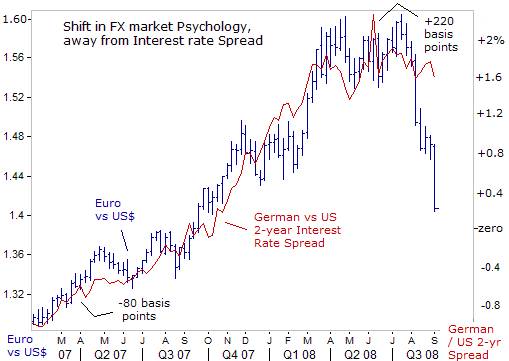
Today, the German 2-year schatz still commands a hefty +165 basis point advantage over the US-T-note, which just a few months ago, was sufficiently high enough to buoy the Euro within a tight range of $1.540 to $1.600 in the second quarter. And there's no indication that the Euro's wide interest rate advantage over the US-dollar is about to shrink in the months ahead, neither by a series of rate cuts by the ECB, nor by a series of rate increases by the Fed.
On Sept 4th , ECB President Jean-Claude Trichet ruled out a rate cut anytime soon. “We just increased interest rates in July to 4.25%, to deliver price stability during the course of 2010. We never pre-commit, and we always do what is necessary to maintain price stability. At face value, today's press conference should have dispelled any rate cut speculation for some time,” he warned.
On the flip side, the Fed won't raise rates after the US economy lost 84,000 jobs in August, and the jobless rate jumped to 6.1% in August, a 5-year high. The US economy has shed 610,000 jobs for eight straight months, something that has happened only eight other times since the end of the World War Two. In each instance, the string of job losses signaled a US economic recession.
Worse yet, eleven US banks have failed so far this year, and the FDIC classified 117-banks as a “problem” in the second quarter, up 30% from Q'1. Nearly 1.2 million US homes are in foreclosure, weighing on a fragile market, with no bottom in sight for home prices. “You simply must accept that the credit crisis is far from over,” warned Federal Deposit Insurance Corp chief Sheila Bair on Sept 4 th . She urged banks to strengthen their reserves. “It's a tough slog but there's no easy way out,” she said .
 Bair expects more US bank failures which could exceed the FDIC's $45 billion insurance fund. However, she noted the FDIC can tap into a $30 billion long-term line of credit with the US Treasury Department and up to $40 billion of short-term credit. Yet even a rash of US bank failures and the swirling crisis engulfing Lehman Brothers, LEH, Wall's Street's fourth biggest investment bank, hasn't put a dent in the US-dollar's newly minted Teflon armor.
Bair expects more US bank failures which could exceed the FDIC's $45 billion insurance fund. However, she noted the FDIC can tap into a $30 billion long-term line of credit with the US Treasury Department and up to $40 billion of short-term credit. Yet even a rash of US bank failures and the swirling crisis engulfing Lehman Brothers, LEH, Wall's Street's fourth biggest investment bank, hasn't put a dent in the US-dollar's newly minted Teflon armor.
Lehman's 8% preferred-J shares plummeted to $8 per share, lifting its junk-status yield to 25%, after an eleventh-hour rescue attempt by the Korea Development Bank (KDB) was placed in doubt. True to form, the credit rating agencies are still touting LEH's credit status at single “A” even though the company is essentially locked out of the credit markets. The cost of protecting Lehman's debt with credit default swaps for five-years rose to 590 basis points, or $590,000 a year to protect $10 million of debt, up from 325 basis points the previous day.
When a bank loses the confidence of its customers, it can evaporate very quickly, just like Bear Stearns. During the Bear Stearns crisis, the cost of insuring its debt only went up to 450 basis points. Odds are Lehman won't be the last major US bank pushed to the brink. Less than 48-hours earlier, the US government seized mortgage giants Fannie Mae and Freddie Mac, after it discovered they had cooked the books, and didn't hold sufficient capital to cover their losses.
Arab Oil kingdoms Rescue the US-dollar
Yet despite all this negative news for the US-dollar, currency traders are putting a positive spin on whatever mud that's thrown at the greenback. What's behind this sea-change in market psychology towards the US-dollar, where the focus has shifted away from interest rate differentials, and instead, has veered-off towards other key factors? They are several reasons that are beyond the scope of this article, but were highlighted in the August editions of the Global Money Trends newsletter.
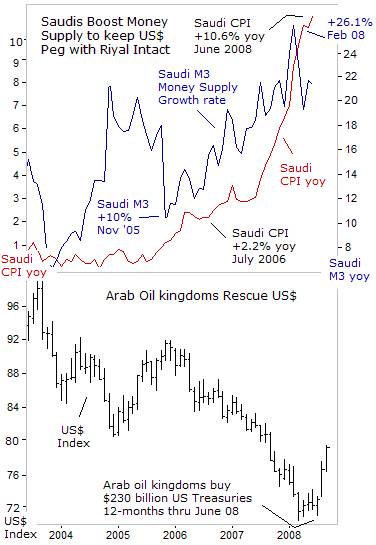
Throughout the US-dollar's tortuous 40% slide over the past six-years, the Arab oil kingdoms in the Persian Gulf stayed loyal to their archaic US-dollar pegs, even while the Fed's indifference to the sliding US-dollar sent inflation shock waves through their dollar-linked economies. Saudi Arabia was forced to expand its M3 money supply by more than 20% in order to defend the dollar peg, which in turn, fueled inflation to +11.1% in July, it's highest in 30-years. In Abu Dhabi , the biggest member of the UAE federation, prices were 12.9% higher in June.
The Arab oil kingdoms rescued the US-dollar from the brink of collapse, by rapidly expanding the supply of Kuwaiti dinars, Saudi riyals, and UAE dirhams, and then recycled about $250 of Petro-dollars into US Treasuries over the past 12-months, through their brokers in London . In return, the US armed forces are defending the Arab Oil kingdoms from their dangerous neighbors to the north in Iran , which seeks nuclear weapons, and is closely aligned with czarist Russia , and Venezuela 's mercurial kingpin Hugo Chavez, - forming the “Axis of Oil.”
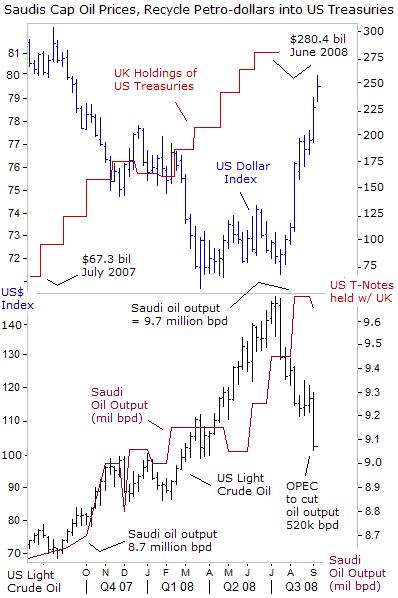
The recycling of Arabian Petro-dollars into US Treasuries put a floor under the US $ Index at the 70-level this summer, and persuaded bearish currency traders to cover massive short positions that had been built-up in the US $ over the past six-years. King Abdullah of Saudi Arabia upped the ante, in support of the dollar, by boosting the kingdom's oil output by 1.1 million barrels per day (bpd) from a year-ago to 9.7 million in July, which finally deflated the crude oil bubble by $45 barrel so far.
On Sept 3 rd , Saudi Arabia announced that it had started pumping crude from the Khursaniyah field, which would boost the kingdom's output capacity by 500,000 bpd to around 11.8 million barrels, and aims to boost its total oil production capacity to 12.5 million bpd by the end of next year. But with crude oil experiencing its largest slide in history, (in dollars) OPEC hawks Iran and Venezuela called for production cutbacks, to put a floor under the market at $100 /barrel.
On Sept 8th, OPEC chief Chakib Khelil said he expected the oil market to be oversupplied at the end of this year. “There is plenty of oil in the market, stocks are pretty good. There will be an oversupply of one-million bpd by early next year,” he predicted. Khelil also noted that oil prices were easing as the value of dollar rose. US crude fell to under $102 as the dollar hit an 11-month high against the Euro. “What we are seeing now is the inverse relationship between the US dollar and the oil price is verified. The dollar is strengthening, the oil price is going down,” he added.
Arab oil kingdoms Aim for Election of “Maverick” McCain
On the eve of the OPEC meeting in Vienna , a senior OPEC source told the al-Hayat newspaper that, “Reducing production, in such conditions, especially before the first quarter of the year, when oil demand increases, would be unjustified.” The OPEC source revealed Riyadh 's price target, “The current price is close to a level that reflects market fundamentals in terms of supply and demand, which indicate levels of $90 to $100 a barrel. OPEC should be cautious and should monitor the market situation closely to prevent a big drop in prices,” he said.
In a compromise, to placate the mullahs in Tehran , the Saudis agreed to a surprising cutback in oil output, in an effort to stabilize the market. OPEC is pumping roughly 790,000 bpd above target, the bulk of which comes from Saudi Arabia , the central banker of oil, which is pumping around 750,000 bpd above its official quota. “If you do your own calculations properly, OPEC will be a lowering its production by about 520,000 barrels per day,” said OPEC chief Khelil.
 But the Arabian monarchs also have their eyes on the US political calendar, and have driven oil prices lower, in order to help John “Maverick” McCain get elected, and become the next commander in chief of the US armed forces in the Persian Gulf . On August 31 st , South Carolina Senator Lindsey Graham reminded the Arab oil kingdoms that Democratic vice-presidential nominee Joe Biden lacked the backbone to stand up to powerful foes or to fix broken governments in the Middle East .
But the Arabian monarchs also have their eyes on the US political calendar, and have driven oil prices lower, in order to help John “Maverick” McCain get elected, and become the next commander in chief of the US armed forces in the Persian Gulf . On August 31 st , South Carolina Senator Lindsey Graham reminded the Arab oil kingdoms that Democratic vice-presidential nominee Joe Biden lacked the backbone to stand up to powerful foes or to fix broken governments in the Middle East .
“Biden has national security experience. But experience and judgment need to come together. Biden voted against the first Gulf War to evict Saddam Hussein from Kuwait . He opposed the surge in Iraq . He wants to partition Iraq ,” Graham said. As chairman of the Senate Foreign Relations Committee, Biden did oppose the recent US troop buildup to defeat al-Qaeda and has called for separating Iraq into three autonomous provinces - Shiite, Sunni, and Kurdish, which is diametrically opposed to the views of the Arab oil kingdoms in the Persian Gulf .
Between now and Nov 4 th , the Saudi and Kuwaiti monarchs will attempt to put a lid the oil market, allowing US gasoline prices to trickle lower, and ease the anxieties of jittery swing voters who are worried about the economy. Soybean and corn prices have already plunged by 30% since early July, in sympathy with lower oil prices, and with a little bit of luck, Americans might see lower food prices before the November 4 th election. What's likely to happen to the oil market after Nov 4 th , will be presented in the upcoming Sept 12 th edition of Global Money trends.
Currency Traders betting on “Maverick” McCain
Not since the contest between Jimmy Carter and Ronald Reagan in 1980, has expectations of the outcome of a US-presidential election impacted the currency markets in a big-way. In 1980, any signal that Carter was pulling ahead in the polls, would send the dollar plummeting in the foreign exchange market. Conversely, Reagan's landslide victory, by a 51% to 41% margin in the popular tally, and a whopping 489 to 49 in electoral-college votes, set in motion a vigorous four-year bull-run for the US dollar, and lifted the greenback to 3.50 German marks.
In 1980, when Reagan defeated Carter, the British pound lost 10% vs the dollar after six-months, 22% after one-year and 47% by the end of Reagan's first term. The “Reagan Revolution” included big tax cuts, and wide swaths of working-class Democrats defected to the Republican Party, which Mr McCain hopes to attract in the weeks ahead, with his plan to stimulate the US economy by cutting the corporate tax rate 10% to 25%, and extending the Bush tax cuts beyond 2010.

There are several reasons that explain the sudden plunge in the Euro, including the unwinding of “yen carry” trades, but few traders have noticed that the dollar's resurrection is mirroring the odds of a McCain victory in November. Futures traders dealing at the on-line parlor Inntrade, based in Dublin , Ireland , have lifted their bids on “Maverick” McCain to a 47.5% probability of winning the election, up from 30% in mid-July. The perceived shift in “Maverick” McCain's” political fortunes are linked to the latest Gallup poll, putting him 5% ahead of Mr Obama, due to a huge 15% shift of independent voters and women, leaning towards Alaskan governor Sarah Palin.
Governor Sarah Palin of Alaska introduced herself to America before a roaring crowd at the Republican National Convention last week, as “just your average hockey mom” then pitched herself as a champion of government reform, sliced and diced Democratic candidate Barack Obama as an elitist, and attacked the liberal media. McCain wants to put Sarah Palin in charge of US oil and energy policy if he becomes president, to lessen American dependence on foreign sources of oil, which in turn, could have a big impact on the dollar in the years ahead.
Alongside McCain's jump in the polls, the US-Dollar Index rallied 12% towards the 80-level, gaining support from the emergence of a militaristic Russia, which invaded South Ossetia and Abkhazia , and threatened to cut-off energy supplies to Europe. Kremlin kingpin Vladimir Putin has refurbished the US-dollar's traditional status as a “safe haven” currency. Not since the end of the Cold War, has the US-dollar been treated as a “safe-haven” currency in times of dangerous geopolitical turmoil.
 Nowadays, the Persian Gulf oil kingdoms regard the possibility of a nuclear armed Iran as a “dire and direct threat” to their own existence, and are flocking to the US-dollar as a safe haven. The sovereign wealth funds (SWF's) controlled by Dubai, Abu Dhabi, Kuwait and Saudi Arabia have roughly $1.7 trillion between them, dwarfing the largest private equity funds in the world. During the first half of 2008 alone, Saudi Arabia raked in $192 billion from oil exports, just $2 billion less than the kingdom's total oil export revenues in 2007.
Nowadays, the Persian Gulf oil kingdoms regard the possibility of a nuclear armed Iran as a “dire and direct threat” to their own existence, and are flocking to the US-dollar as a safe haven. The sovereign wealth funds (SWF's) controlled by Dubai, Abu Dhabi, Kuwait and Saudi Arabia have roughly $1.7 trillion between them, dwarfing the largest private equity funds in the world. During the first half of 2008 alone, Saudi Arabia raked in $192 billion from oil exports, just $2 billion less than the kingdom's total oil export revenues in 2007.
With their enormous size, the Persian Gulf SWF's can easily move global financial markets. By 2015, the Persian Gulf SWF's could grow to $5-6 trillion. If Chinese, Russian, and Korean SWF's are taken into account, the total global SWF value could top $12 trillion, or almost equal to the output of the Euro-zone's economy. SWF's are quickly becoming the most powerful investors in the world, and account for 12% of the trading volume in commodities. Their activities will increasingly impact financial markets, and the distribution of strategic resources.
Raging Russian Bear Tarnishes Euro's Image
Currency traders are wondering just how far Vladimir Putin is prepared to extend Russia 's influence in Asia, Europe and the Middle East . Last month, the Kremlin ordered an invasion of Georgia to prevent it from joining NATO, and its army stands within 50-miles of a new oil pipeline, that carries one-million barrels per day of crude oil from the Caspian Sea to the Turkish port of Ceyhan , and jeopardizes Russia 's stranglehold over energy supplies to the European Union.
Armed with $580 billion of foreign reserves (the third largest), Kremlin kingpin Vladimir Putin has become increasing bold, and is willing to use military power to counteract what Moscow considers an unacceptable level of US infringement on its interests in the Middle East and Central Asia. “We are not afraid of anything, including the prospect of a Cold War,” warned President Dmitry Medvedev.

Russia holds the world's largest natural gas reserves and the eighth-largest oil reserves. It supplies one-quarter of Europe 's oil supply and 30% of its natural gas. In July, deliveries to the Czech Republic through the Druzhba pipeline were cut by 40% after Prague signed an agreement with the US to install an anti-missile shield. The emergence of a militaristic Russia , under former KGB spy master Putin, in alliance with the “Axis of Oil,” has tarnished the Euro's stellar image, and added an extra degree of risk in investing in European stock markets.
Putin has declared that a new Cold War with the West has already begun and is considering arming Russia 's Baltic fleet with nuclear warheads and pointing them at European cities. “Of course we are returning to those times. It is clear that if a part of the US nuclear capability turns up in Europe , and, in the opinion of our military specialists will threaten us, then we are forced to take corresponding steps in response. The strategic balance in the world is being upset and in order to restore this balance, we will be creating a system of countering that anti-missile system. Naturally, we will have to have new targets in Europe ,” Putin warned.

Since Russia invaded South Ossetia and Abkhazia on August 7 th , the Kremlin's foreign exchange reserves have declined by $16.4 billion, the biggest outflow of capital since the country's financial meltdown in 1998. Foreign investors, who hold roughly half of all Russian shares outstanding, many listed in London and New York, have sold an estimated $20 billion of Russian stocks. The Russian central bank was forced to sell US$5 billion in the foreign exchange market to stabilize the Russian rouble, after it tumbled 10% against the resurgent US$, to a one-year low.
While the Kremlin's coffers have mushroomed, the Russian corporate sector is still heavily reliant on foreign investors. The local bond market is small, with just $60 billion worth of ruble issues. Russian companies borrow funds on the world capital markets, and foreigners own half of the $1 trillion debt. But now, Russian companies are facing a liquidity crunch, since foreign lenders are balking and won't touch any Russian paper. The impact on the Russian stock market has been severe.
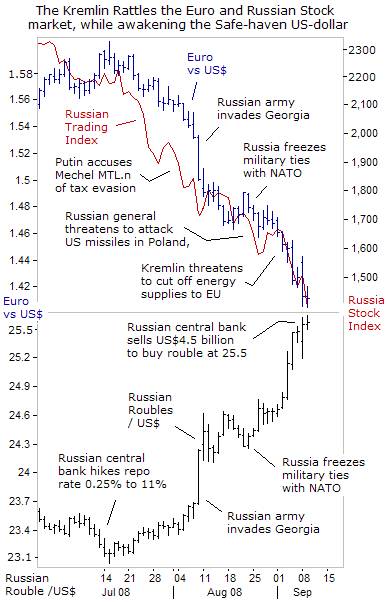
The Russian Trading system Index (RTS) was roiled by the exodus of foreign investors, who are on high alert for political risk. Since peaking in May, the Russian stock market plunged 40%, shaving roughly $500 billion from the value of Russian stocks . Foreigners dumped large blocks of Russian mining companies after Kremlin kingpin Putin, accused a large steel and coal mining company, Mechel, MTL.n of tax evasion, causing its share price to collapse. When Putin targets a company, there can be dire consequences, such as the demise of Yukos, a big oil company that was bankrupted on trumped-up tax charges.
Roughly half the RTS Index is comprised of energy related companies, which have also been hard hit, by the slide in crude oil prices to $102 /barrel. Soaring oil prices were behind Russia 's political and economic resurgence, and help lift the RTS Index by an astounding 720% from six-years ago. But nowadays, the term “Peak Oil” is invoking images of a peak in oil prices and global demand, due to a synchronized slide in the global economy, rather than fears that the world is running out of oil.
One big surprise at this week's OPEC meeting was the presence of Russian deputy prime minister Igor Sechin, sent by Putin, who announced that “Broad cooperation with OPEC is one of Russia 's top priorities. OPEC is one of Russia 's key partners on the global oil market.” In the past, Russia has agreed to trim production in line with OPEC output cuts to support prices, and traders must monitor Putin's next move.
Most interesting is the observation that the Euro's slide against the US $, is the near-perfect inverse image of the US-dollar's climb against the Russian rouble. The emergence of militarist Russia , ready to aim its nukes at Europe, and a stranglehold over Europe 's energy supply, has triggered a mini-flight of capital from the Euro and the Russian rouble. In contrast, the US-dollar, backed by the world's most powerful military, wins by default as a safe haven.
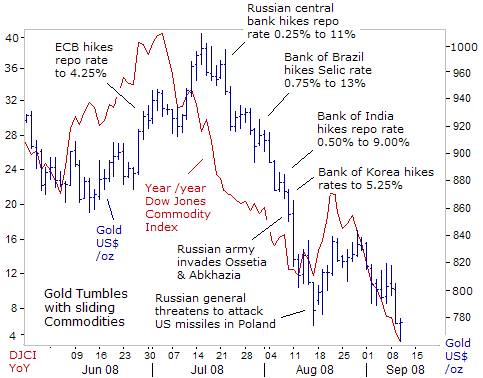
Gold has a role as a “safe haven” in times of geo-political instability, hasn't gained much traction from heightened tension between the Kremlin in the West, or Iran 's drive to acquire nuclear weapons. Instead, gold is tracking the global commodity markets, for clues about the direction of inflation. Since peaking at a record high on July 3 rd , the annual rate of change for the Dow Jones Commodity Index has plunged from a +40% clip to as little as +4% today. One doesn't need a degree in Newtonian physics, to figure that headline inflation numbers, designed by government apparatchiks, will show sizeable declines in the months ahead.
On September 5 th , the Global Money Trends newsletter identified the 3 most important market signals (not including the direction of the US $), that can help traders forecast the direction of the commodities markets. The special report also includes a big picture outlook for the global economy and stock markets.
Foreign Exodus from Brazil 's Bovespa, undermines Brazilian real
Yet there appears to be more reasons behind the US-dollar's rally against all major foreign currencies, than just its newly polished image as a “safe-haven” currency. Brazil is not under any threat of military attack from Russia or Iran, and it's self-sufficient in energy, yet it's currency, the real, has lost -14% against the US-dollar in recent weeks, even though Brazil's interest rates are +11% higher.
Foreign investors pulled money out of Brazil 's stock market for a third straight month in August, triggered by the steepest plunge in commodities in five decades. Slumping commodity prices led Sao Paulo's Bovespa stock index sharply lower, to below the psychological 50,000-level, or 34% off from its May 20 th all-time high. More than half of the Bovespa index is made up of natural resources companies and steel mills, whose fate largely hinges on the direction of the global economy.
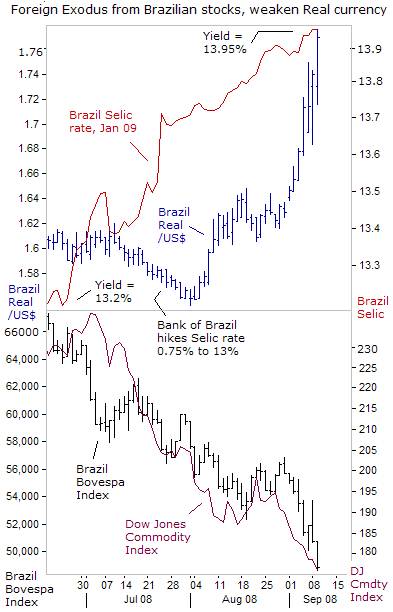
The Dow Jones Commodity Index has tumbled 27% from a record high set eight weeks ago. Steel prices have plunged 30%, and soybeans are 30% lower. Brazil had posted a trade surplus of $40 billion last year on exports of $160 billion, and strong demand for commodities helped secure a 27% jump in exports, from January to July of this year, compared to the same period a year ago.
Latin America's largest economy enjoyed a current account surplus for the last five years, its currency rose to a nine-year high while the central bank stockpiled enough US-dollars to pay off its entire foreign debt and become a net creditor for the first time. But imports are growing at twice the rate of exports this year, due to the super-strong real, and Brazil 's trade surplus plunged 42% in the first half of this year. Now the virtuous cycle is moving in reverse, as commodity prices slide, and foreigners repatriate their money, to avoid losses related to the Bovespa index.
The Brazilian real has plunged 10% in the past 10-days to 1.77, its lowest level against the dollar since February. The performance of Brazil 's currency and stock market, which largely hinge on the direction of commodity markets, haven't differed much from Russia 's. These top-2 emerging markets are leveraged plays on the global economy, and when commodities trend lower, it has a double barreled selling effect on emerging markets. There's no decoupling from the developed economies of Europe, Japan , and the US , which account for 65% of global GDP.
This article is just the Tip of the Iceberg of what's available in the Global Money Trends newsletter. Subscribe to the Global Money Trends newsletter, for insightful analysis and predictions of (1) top stock markets around the world, (2) Commodities such as crude oil, copper, gold, silver, and grains, (3) Foreign currencies (4) Libor interest rates and global bond markets (5) Central banker "Jawboning" and Intervention techniques that move markets.
By Gary Dorsch,
Editor, Global Money Trends newsletter
http://www.sirchartsalot.com
GMT filters important news and information into (1) bullet-point, easy to understand analysis, (2) featuring "Inter-Market Technical Analysis" that visually displays the dynamic inter-relationships between foreign currencies, commodities, interest rates and the stock markets from a dozen key countries around the world. Also included are (3) charts of key economic statistics of foreign countries that move markets.
Subscribers can also listen to bi-weekly Audio Broadcasts, with the latest news on global markets, and view our updated model portfolio for Q'1, 2008. To order a subscription to Global Money Trends, click on the hyperlink below, http://www.sirchartsalot.com/newsletters.php or call toll free to order, Sunday thru Thursday, 8 am to 9 pm EST, and on Friday 8 am to 5 pm, at 866-553-1007. Outside the call 561-367-1007.
Mr Dorsch worked on the trading floor of the Chicago Mercantile Exchange for nine years as the chief Financial Futures Analyst for three clearing firms, Oppenheimer Rouse Futures Inc, GH Miller and Company, and a commodity fund at the LNS Financial Group.
As a transactional broker for Charles Schwab's Global Investment Services department, Mr Dorsch handled thousands of customer trades in 45 stock exchanges around the world, including Australia, Canada, Japan, Hong Kong, the Euro zone, London, Toronto, South Africa, Mexico, and New Zealand, and Canadian oil trusts, ADR's and Exchange Traded Funds.
He wrote a weekly newsletter from 2000 thru September 2005 called, "Foreign Currency Trends" for Charles Schwab's Global Investment department, featuring inter-market technical analysis, to understand the dynamic inter-relationships between the foreign exchange, global bond and stock markets, and key industrial commodities.
Copyright © 2005-2008 SirChartsAlot, Inc. All rights reserved.
Disclaimer: SirChartsAlot.com's analysis and insights are based upon data gathered by it from various sources believed to be reliable, complete and accurate. However, no guarantee is made by SirChartsAlot.com as to the reliability, completeness and accuracy of the data so analyzed. SirChartsAlot.com is in the business of gathering information, analyzing it and disseminating the analysis for informational and educational purposes only. SirChartsAlot.com attempts to analyze trends, not make recommendations. All statements and expressions are the opinion of SirChartsAlot.com and are not meant to be investment advice or solicitation or recommendation to establish market positions. Our opinions are subject to change without notice. SirChartsAlot.com strongly advises readers to conduct thorough research relevant to decisions and verify facts from various independent sources.
Gary Dorsch Archive |
© 2005-2022 http://www.MarketOracle.co.uk - The Market Oracle is a FREE Daily Financial Markets Analysis & Forecasting online publication.


